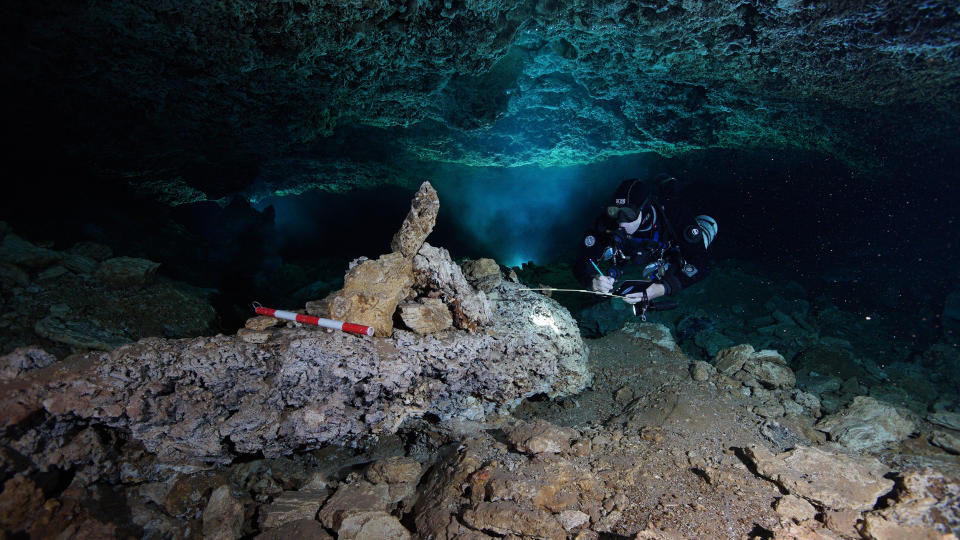Deep in since-flooded caves, researchers find evidence of America's first miners
Sam Meacham has spent years studying the miles of caves beneath Mexico’s Yucatán region.
Although they are now flooded, most of the caves in Quintana Roo state were dry and accessible until about 8,000 years ago, when sea levels rose at the end of the last Ice Age. It was known that the ancestors of modern Native Americans ventured into the pitch-dark caves, which extend for hundreds of miles beneath the limestone landscape. Human bones have been found deep within the caves, hundreds of yards from the entrances, and archaeologists have proposed that people went there in search of fresh water or to perform rituals.
Meacham and his CINDAQ dive team had seen “weird” things in other parts of the Sagitario cave, such as signs of digging and piles of rocks, that they could not explain. Then, in 2017, Meachem was mapping a section of the cave known as La Mina, beyond a narrow part of their passage from the surface, when he encountered something that has changed how archaeologists think about the earliest peoples of the Americas.
"When we slipped through the narrow passageway to the other side … it all kind of finally fell into place for us,” Meacham said.
Meacham found signs people mined there more than 10,000 years ago for a valuable pigment — red ochre — known to be used in rituals, according to research published Friday in the journal Science Advances.
The divers saw extensive evidence of red ochre mining – including pits dug in the cave floor, vivid traces of ochre, stone tools, and charcoal from fires to provide light.
The discovery makes the ancient explorers of the cave perhaps the earliest miners anywhere in the Americas.

Red ochre is a mineral rich in iron oxides used as a red pigment by many ancient cultures.
Its color has been likened symbolically to the color of blood, and it was used in rituals for hundreds of thousands of years, especially in burials and in body paints.
It may have had medicinal uses, too, and could be used to tan hides or as a pest repellent.
“Red ochre played multiple roles within these communities,” said Brandi MacDonald, an archaeologist at the University of Missouri and a lead author of the research. “It could have served both symbolic and utilitarian functions, and its uses could have changed over time.”
The researchers can’t tell exactly how the ochre from the Quintana Roo caves was used, but it may have been especially valuable because it is exceptionally fine-grained – “ready-made paint,” MacDonald said – and has high traces of arsenic, which could have enhanced its medicinal qualities.
The ancient ochre mine was discovered in 2017 in the Sagitario cave, about 5 miles from the Caribbean coastline.
Research shows the mine dates from between 11,400 and 10,700 years ago – a few thousand years after humans arrived in the Americas from Asia – and that at least two other nearby caves were also used to mine red ochre.
“It must have been quite valuable in terms of the amount of effort to find it and [mine] it,” said geoarchaeologist Eduard Reinhardt of McMaster University, a lead author who dived into La Mina to take samples from the ancient mine. “It required a lot of social organization.”

Teams of at least three people carried out the mining, removing rocks and stalagmites to dig pits in the floor of the cave where the ochre deposits were found, said archaeologist James Chatters of Applied Paleoscience, another of the lead authors.
Others probably carried in firewood to keep the cave lit and carried the mined ochre outside, he said.
Some of the bones in the Quintana Roo caves appear to be from people who had lost their way.
“If you let your fire go out, 600 [yards] deep in the cave system, you’re in trouble,” Chatters said. “It’s a labyrinth.”
Archaeologist Loren Davis of Oregon State University, who was not involved in research, explained that very little evidence of early humans survives in the Yucatán.
“It is a hot, steamy jungle and things just don’t preserve well there,” he said. “The researchers have basically found the sweet spot where archaeological information is going to be preserved.”
Anthropologist Matthew Des Lauriers at California State University, San Bernardino, said the study showed America’s earliest peoples went to incredible lengths to mine ochre – an unmistakable sign that they shared the same interests as other ancient peoples.
“The pathway that our ancestors took is marked with red ochre,” he said. “To find these uniquely human expressions, and at this great antiquity, in the Americas is really special.”

